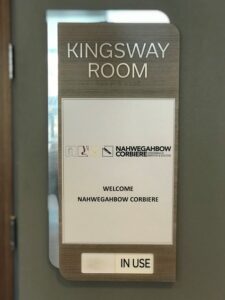Canada, Ontario, and Robinson Huron Treaty Leadership Announce two-week mediation

By Catherine Murton Stoehr
SUDBURY — Canada and Ontario were in a tight corner: staring down a dispassionate, nonpartisan court set to tot up potentially astronomical sums they owed to the Robinson Huron communities for 149 years of underpayment of treaty annuities pegged to resource revenues in one of Canada’s richest mineral resource regions. On Jan. 16, the day the “accounting trial” was about to begin, Canada and Ontario agreed to sit in mediation with the Robinson Huron leadership, staving off what was likely to be a punishing reckoning from the court.
The 21 Robinson Huron communities have had success in the first two of three trials dedicated to examining the Robinson Huron communities’ claim that Canada and Ontario have failed to meet their obligations under the 1850 Robinson Huron Treaty. At issue in the now postponed third trial: how much money did Canada and Ontario short the communities every year since 1874? What government infrastructure and social service spending should be counted as legitimate offsets against those debts, again, year by year? How should resource revenues be divided going forward? And more, so much more.
Murray Sinclair, former Senator and Chair of the Indian Residential Schools Commission, has accepted the daunting task of overseeing the mediation.
Canada and Ontario’s willingness to negotiate was foreshadowed in mid-December when the ranking ministers of both governments’ Indigenous departments met in ceremony with Robinson Huron leadership for the first time since the treaty was negotiated in 1850. Long-time Robinson Huron Treaty Litigation Committee member and former Ogimaa (Chief) of Wiikwemkoong Unceded Territory Duke Peltier said that that meeting and a guarantee of annual meetings going forward is the most important element to what he calls “treaty renewal.”
Taking a moment away from a Special Chief’s Meeting being held in Sudbury, Peltier said that the Crown forgot its treaty obligations and the failure to properly augment the annuity is just one example of multiple harms born of that forgetfulness.
“In 1764 [at the Treaty of Niagara], the British Crown promised to hold annual meetings to address issues experienced in the communities” and even between those meetings, the British promised that the Anishinabek would not have to go far to call the British for a conversation, they could pull on their end of the Covenant Chain and the British would make themselves available without delay.
What a contrast to today’s reality in which Canada and Ontario came to the meeting at the last possible moment and only after decades of requests and admonitions. This litigation began in 2017, but the leadership and members of the 21 communities involved have been working for three decades to put together the resources, research, legal team, and protocols to sustain a multiyear litigation against a team of full-time federal and provincial lawyers.
Ogimaa Dean Sayers of Batchewana First Nation put the current litigation into perspective. His community of Batchewana and the other communities did not gain rights to annuity payments in the 1850 Treaty, but rather, the British gained a share in the Anishinabek’s pre-existing and unceded right to benefit from the proceeds of their territory. Ogimaa Sayers illustrated his point by saying that when the Chiefs arrived at Bawating (also known as Sault Ste. Marie) to negotiate the treaty, their canoes were so weighed down by the Anishinabek’s laws, land, water, and moose and deer, that they barely cleared the surface of the water. At Bawating, they took a few of those items from their canoes and put them in the visitors’ ships, but when they left the negotiations, the Anishinabek carried their jurisdiction and laws and the land and the water and the air back home with them in their canoes.
Ogimaa Sayers says that the idea that Canada and Ontario have jurisdiction to determine what small shares of the proceeds of the land go to the Anishinabek is wrong. The older people at Batchewana have told Ogimaa Sayers that the agreement was a 50/50 split with allowances made for necessary expenditures.
Not only that, but the mistaken perception that the Anishinabek were not aware of, or active in large-scale trade is demonstrably false. Ogimaa Sayers relayed that the Lake Huron and Superior communities had always mined copper and traded it as far south as to the Seminoles in Florida. They determined who mined in their territories and issued permits. When the British overstepped their jurisdiction by issuing permits for people to mine in Robinson Huron and Superior territory, the community leaders and warriors stopped one of the resulting mining projects using a canon they had borrowed, not because they objected to mining or profiting from mining, but because Britain had no right to issue permits on their territory without a treaty.
History began catching up to Canada and Ontario when Justice Hennessy of the Ontario Superior Court found in favour of the Robinson Huron communities in the first trial, determining that the treaty obligated the Crown to increase annuity payments relative to increases in profits from the territory, and that Ontario and Canada did not have, as they asserted, sole authority to determine how much those increases should be and when they should be made. Authority to review the annuities rests with the court.
The Robinson Huron communities were then successful in the second trial in which Justice Hennessy dismissed multiple legal objections to the Anishinabek’s claims put forward by Ontario and Canada, intended to diminish or negate their obligations under the treaty.
Canada and Ontario face strong headwinds if the mediation fails and they return to court. The Crown’s transparently self-serving contention that it alone has the authority to interpret and carry out the provisions of the treaty is growing increasingly threadbare. The communities’ account of a fair and reasonable reciprocal agreement with practical built-in protocols for annual meetings to safeguard mutual understanding and trust, is far more credible.


